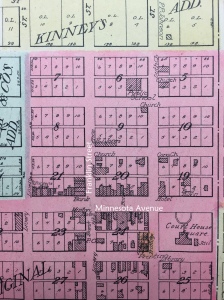We have had several researchers asking about the early churches in Glenwood, so I thought I would share a bit of the information with all of you.
This map from 1910 shows the locations of the early churches in Glenwood. The Lutheran and Methodist churches were on block 5. (Today Central Square is located between blocks 6 and 5.) The Catholic church was on block 9. That is the only early church building still standing. It is an apartment building today. The Congregational church was on block 19 and the Episcopal church was on block 20. Today, the Episcopal church is here on the grounds at the Pope County Historical Society.
Jim Gloege wrote a lovely description of church hill that I will share with you all here.
Church Hill – by James Gloege
Were I to choose some visible signature for Glenwood’s coming-of-age decade, it would have to be the tall, gleaming white apartment structure that so strikingly holds the brow of the hill overlooking Franklin Avenue from Central Square. There isn’t a handsomer example of architectural “re-purposing” anywhere, nor perhaps is there any other building that so deeply bespeaks our town’s innermost past…because it represents no less than five churches that stood, during that decade, on or near what was then called “church hill.”
At that time two of Glenwood’s original wooden churches, the Lutheran and the Methodist, held the space now occupied by Central Square’s parking lot. Both had their own adjourning burial grounds – later moved away to constitute the beginnings of our present-day cemetery. Just one block down the street from these two churches in the direction of the Court House stood a similarly old Congregational Church which was replaced in the middle of the same decade by a new and grander one – that sand-colored stone edifice long to be Glenwood’s showiest public building. Exactly one block downhill from there, tucked between a lumber yard and hotel on Franklin Avenue, stood the graceful little Episcopal Church building which was later moved up amongst the others at the top of the hill – and still later to the Historical Society grounds where you can see it today. And lastly, in 1903, local Catholics constructed
the only one of all these church buildings still to be found on the hill.
Between 1901 and 1910 Glenwood grew prodigiously and attained, very nearly, the population it has held ever since. Behind the stable numbers however, mighty shifts are symbolized by the fate of church hill. The Congregational and Methodist flocks flourished for a time but ultimately shrank, and finally united with each other while Episcopalians disappeared altogether: all this as our Yankee blood migrated restlessly westward – the Vermonters and upstate New Yorkers, those Kinneys and Lathrops who had founded and largely dominated 19th century Glenwood. Meanwhile both Lutheran and Catholic congregations have grown into their larger churches built on other sites, as more and more Norwegian and Czech families filled in the community from the outlying townships. But what this gleaming white building on the hill recalls for us today was a decade of rich balance when the bells marking each baptism and wedding and funeral across five
denominations rang so regularly and at such close range as to sound as one heartbeat for the town.





Thanks to Jim for putting this together. As a member of the Congregational Church, I have such fond memories of the many educational and religious activities that were provided to us by the church community. The 1950s were a great time to grow up in Glenwood.
Pingback: January 1. A quick look. | glenwoodthenandnow